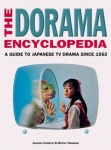
First came anime, the first major cultural export from modern Japan, and then manga established a major beachhead in American bookstores, so what's the next big pop culture trend from Japan? Well according to Jonathan Clements and Motoko Tamamuro, authors of The Dorama Encyclopedia, it could be Japanese TV drama ('dorama'). Don't laugh; although cartoons have a much easier time crossing cultural boundaries and in spite of the fact that world class Japanese filmmakers such as Kurosawa, Ozu, and Mizoguchi have never received their due from American critics or audiences, some Japanese live action TV series have already had a major impact in the U.S. The Mighty Morphin' Power Rangers brought the Japanese TV tradition of the 'sentai' (or 'battle team') series to the U.S. with considerable success (and staying power). And if you don't live in Hawaii or California, you may be unaware of the fact that over 150 of the 1,000 series included in The Dorama Encyclopedia have already been broadcast in English.
But whether Daughter of Iguana or any of the other fascinating series discussed in this volume ever get major play in the US or not, The Dorama Encyclopedia, which arrives this month from Stonebridge Press is a book that anyone with a serious interest in Japanese popular culture will have to read. Jonathan Clements, who was co-author of the invaluable Anime Encyclopedia, and Motoko Tamamuro, who was a key researcher on that project, have performed a real service by producing this guide live action Japanese television productions. In a short history of Japanese television prefacing the volume, the authors point out the influence of American TV programs on Japan -- how certain series such as Bewitched and I Dream of Jeannie had a key influence on the 'magical girl' anime series. The authors also point out that although foreign influence waned as Japan's economic recovery from WW II strengthened, in 1958 the George Reeves Adventures of Superman was the number one show in Japan.
But far more interesting than these often overlooked examples of American influence on Japanese culture are the relationships that anyone familiar with anime and manga can see between Japanese live action TV programs and Japanese animation and comic books. Manga's pervasive influence on Japanese culture can be seen again and again throughout this volume, which contains numerous examples of TV shows based on popular manga series. Equally interesting is the relationship of anime and dorama, with examples of anime series that inspired live action shows, as well as live action series like Kikaider, which have been made into successful anime. The Dorama Encyclopedia is also a 'must read' for fans of 'kaiju' (Japanese monster films) and anyone interested in the long history of the 'sentai' series. Retailers who may have overlooked The Dorama Encyclopedia in Diamond's Previews or FM's Request Line catalogs should seriously think about carrying what is one of the most interesting and informative volumes of the year. Dealers in anime and manga can and should recommend this volume to the serious fans shopping at their stores -- they won't be disappointed.







